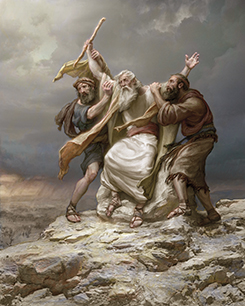How can you lead as a counselor in a bishopric, quorum presidency, or auxiliary presidency? There doesn’t seem to be very much information in Handbook 2 about how to be a counselor. From Handbook 2: section 4.2 “The bishop’s decisions are better informed and implemented when made after discussions with his counselors.” Most of the rest of the handbook just lists what the bishop can delegate to his counselors. So, how do we learn to be an excellent counselor?
We can look to the Old Testament for an example. Remember the occasion when Moses was leading the children of Israel in their battle against the Amalekites. Moses took the rod of God in his hands and went to the top of a sacred mount, where he held up his hands to God over the battle; and as long as Moses held up his hands, Israel prevailed. But when he let his hands down, the Amalekites prevailed. And as Moses’ arms became heavy with weariness, Aaron and Hur stood on either side of Moses and helped him to hold up his hands until the battle was won. (See Ex. 17:8–12.)
8 Then came Amalek, and fought with Israel in Rephidim.
9 And Moses said unto Joshua, Choose us out men, and go out, fight with Amalek: to morrow I will stand on the top of the hill with the rod of God in mine hand.
10 So Joshua did as Moses had said to him, and fought with Amalek: and Moses, Aaron, and Hur went up to the top of the hill.
11 And it came to pass, when Moses held up his hand, that Israel prevailed: and when he let down his hand, Amalek prevailed.
12 But Moses’ hands were heavy; and they took a stone, and put it under him, and he sat thereon; and Aaron and Hur stayed up his hands, the one on the one side, and the other on the other side; and his hands were steady until the going down of the sun.
To me, this picture of Aaron and Hur holding up Moses’ hands is representative of what a counselor does.
As I think about all the times I have been a counselor I believe there are two parts to this responsibility.
1. Counseling together
2. Being a wingman
Counseling Together: As leaders in the Church we all work in councils. We both seek to counsel with others and we speak up and share our perspective in a way that does not antagonize or cause contention but encourages growth and open communication. We need to create an environment where others feel the council allows people to ask hard questions and share opinions. The other side of this coin is that everyone must be receptive and humble when receiving correction or counsel. We we are effectively leading as a counselor we put the interests of the council and what is best for the Church above our personal agenda. Consider this statement by Elder M. Russell Ballard:
“In my experience, lives are blessed when leaders make wise use of committees and councils. They move the work of the Lord forward much faster and farther, like a fine automobile operating at peak efficiency. Committee and council members are unified. Together they experience a much more pleasant trip along the highway of Church service.” (M. Russell Ballard, “Counseling with our Councils”, April 1994 LDS General Conference)
Being a wingman: A wingman is a pilot who flies in formation behind and usually off the right wing of the lead pilot. The term wingman has been expanded to apply to a wide variety of situations. Originally the role of the wingman is to add an element of mutual support during aerial combat. The presence of a wingman increases the capability of both pilots by adding firepower, situational awareness, and increasing the tactical options of the team. In addition to the wingman’s responsibility to stay close to the leader, he also warns of immediate threats and maintains situational awareness so he is ready to assume the lead of the formation at any time. Speaking of wingmen, Elder Robert D. Hales said:
“When I was a lieutenant in the air force, our squadron selected as its motto “Return with Honor.” We realized that this motto applied to all members of the flight. It did not just apply to us as individuals. We flew jet fighter planes in a fingertip formation. For a moment, fold your thumb under your hand and look at the back of your hand with your fingers extended. You will see a flight of four planes with a leader and three wingmen. You are protected on the left and on the right, and the leader is concentrating on his goals. If for a moment you will separate and put two fingers on either side, you will still see a leader and a wingman, one plane ahead of the other, and one plane on the wing to protect. We all knew and were taught from bitter experience that a “loner” out of formation was unprotected and would surely be destroyed.” (Robert D. Hales, “We Can’t Do It Alone”, October 1975 General Conference)
One reason wingmen are so valuable is that they see the world from a slightly different perspective. I believe it is the counselor’s responsibility to bring both his unique talents as well as his or her perspective to the presidency. Each of us are blessed with individual talents and spiritual gifts (Moroni 10:8-18). With three sets of spiritual gifts the capability of the presidency is magnified and their unity offers protection.

